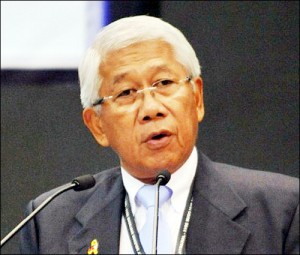The United States is planning the expansion of its military presence in the Philippines, including the stationing of US Navy ships on a temporary basis and the conduct of more frequent joint exercises, in response to China’s growing assertiveness in the Asia Pacific.
Philippine defense and military officials confirmed a Washington Post report on Thursday that the two countries were negotiating a deal that would increase cooperation between the two militaries, but stressed that the tension in the West Philippine Sea (South China Sea) over the disputed Spratly Islands was only part of the equation.
Defense Secretary Voltaire Gazmin said the terms of such an agreement would still be dictated by the Visiting Forces Agreement, which allows the periodic visits of US troops for joint training and exercises.
“Well, first of all, it’s true that the United States wants to expand its presence in the region, which is why they will put up a base in Australia and station ships in Singapore. But in the Philippines, [it involves] exercises that will still be in accordance with our Visiting Forces Agreement,” Gazmin said.
On Thursday, the Washington Post reported that the United States, in talks with Philippine officials in Washington, was considering “operating Navy ships from the Philippines, deploying troops on a rotational basis and staging more frequent joint exercises,” among other options.
‘Political sensitivities’
“Under each scenario, US forces would effectively be guests at existing foreign bases,” the report said. The US daily quoted an unnamed senior Philippine official as saying that the American side was aware of “political sensitivities” surrounding such an agreement.
The report further discounted the possibility of the United States attempting to establish a permanent base some 20 years after the Philippine government rejected a new bases treaty and evicted US forces from their naval base in Subic, Zambales province, the United States’ biggest base in the Pacific.
Asked to comment, Department of Foreign Affairs spokesperson Raul Hernandez said he was still awaiting Foreign Secretary Albert del Rosario’s input on the issue.
There was no comment from Malacañang at press time.
Many factors
The negotiation for such a deal was prompted by many factors, and the tension in the West Philippine Sea with China over claims on the disputed Spratlys was only part of it, according to defense spokesperson Peter Paul Galvez.
“There are many factors, including our position on [maintaining] freedom of navigation and taking a multilateral approach and a rules-based approach in resolving the dispute in the West Philippine Sea,” Galvez said.
The Spratlys, a chain of tiny islands and reefs believed to be rich in resources, lie near the Philippine province of Palawan.
The chain is claimed wholly or partly by the Philippines, China, Malaysia, Brunei, Vietnam and Taiwan.
In 2002, the claimants signed the Declaration of Conduct of Parties in the South China Sea, which was to serve as a nonbinding guideline on how to tackle the disputes. But tension has escalated in recent months, with the Philippines and China trading barbs on the latter’s alleged incursions into the former’s territory.
The Armed Forces of the Philippines said the discussions between the Philippines and the United States showed that “the partnership between our two countries’ armed forces remains healthy, dynamic and beneficial.”
“It continues to highlight the unswerving commitment of our security forces toward a more secure Asia-Pacific region,” said the AFP public affairs chief, Colonel Arnulfo Marcelo Burgos Jr.
He said the Philippine military was looking forward to more joint bilateral exercises and undertakings, such as the annual Balikatan exercises, the Cooperation Afloat Readiness and Training, and the Balance Piston exercises.
‘Light footprint’
The Washington Post report quoted Philippine and US officials as saying that they were “favorably inclined toward a deal.”
Meetings were supposedly scheduled late this week “before higher-level meetings in March.”
“The strategic talks with the Philippines are in addition to feelers that the Obama administration has put out to other Southeast Asian countries, including Vietnam and Thailand, about possibly bolstering military partnerships,” the report said.
But “instead of trying to establish giant bases reminiscent of the Cold War, Pentagon officials said they want to maintain a light footprint,” the report said.
“We have no desire nor any interest in creating a US-only base in Southeast Asia,” said Robert Scher, a deputy assistant secretary of defense who oversees security policy in the region.
“In each one of these cases, the core decision and discussion is about how we work better with our friends and allies. And the key piece of that is working from their locations.” With reports from Tina Santos and Christine O. Avendaño
